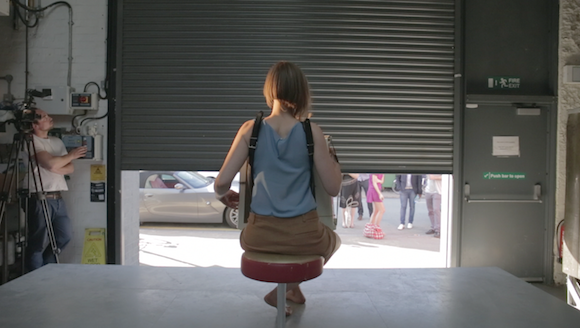
Hello, Lina. Could you share the story behind your Candy Shop performance? Is it a political attempt to deconstruct rap music?
Artistic rather than political. Candy Shop is about the everyday, slowness, sensitivity, depth, femininity, masculinity, modernity, naivety, togetherness and the collective consciousness. The work developed gradually. Occasionally I did performances in which hip hop texts turned into my own sonic and visual re-interpretations.
Later I invited the artists Angharad Davies (a well-known violinist in the improvised music scene), Anat Ben David (member of Chicks on Speed), Sharon Gal, and Rebecca la Horrox to join me. After a while, Heidi Heidelberg and the wonderful Nouria Bah also got involved in the course of producing the open call based work titled Casting. Our collaboration spawned the Candy Shop opera, which was performed most notably at the Queen Elizabeth Hall in London. A video version of the work was filmed during the exhibition Everything I Do, I Do It Big held by the David Roberts Arts Foundation.
What does rap music mean to you? How much falsehood is there in a rap song, and how much cinematic endeavour to turn life into a movie?
It isn’t the music of my teenage years. Neither is it the music of the present for me, or it is just as anything else that exists around us. I approach rap as one of the cultural phenomena that intrigue me.
The semantics of rap music has obviously changed since the moment of its emergence. It contains increasingly less protest and increasingly more sexism and machismo. There is nothing bad about it. Other channels for protest spring up constantly.
I’d say it is fantasy rather than falsehood that is prominent in rap music. Fantasy broadcast by those who fantasise to those who wish to live in the same fantasy, full of money, beautiful women, invulnerable heroes.
Is it possible that rap as a part of popular culture not only influences the thinking of a twelve-year-old, but is designed specifically for that, and hence the whole vocabulary of sexual conquest and humiliation of women is more of a camp performance aimed at other rappers, the brotherhood? Is it not that rap is homo- rather than hetero-erotic, when rhyming, outfits and getting laid are mere decorations meant to impress the scene and the fellow boys? After all, what we see in music videos is most often a group of young men hanging out together, with everything else merely setting the stage for their self-expression and serving as a means to stand out in the group while simultaneously belonging to it.
Well yes, popular music is a great tool for manipulating the masses. It starts at an early age. The catchy rhythm helps one internalize certain texts which then become mantras. The repetition of these mantras shapes the subconscious. To arrive at more specific insights, we should focus on particular examples. My memory stores music videos which have one conqueror protagonist (not necessarily male), while all the other characters, male or female, play Simon Says by default…
Actually, every time I watch rap music videos or read the songs’ lyrics I gasp in astonishment at what I see. Then I decide that it is just extremely sardonic irony.
Yet when observing the surrounding environment I realize that this irony fails to make me smile when it ends up in the sphere of the everyday. It is actually destructive.
What is contemporary art to you?
I am more interested in the circumstances which lead to the emergence of a piece of art. A complete or incomplete form we call art is often but a consequence of those circumstances. The circumstances may be very different. Commission, war, lack of money, art school assignment, struggle against the system, research into supernatural phenomena, living in the woods, boredom. All this acquires the form of art, which eventually becomes a circumstance itself.
What is your take on the discussions about the artists’ need for creative autonomy, and how do those discussions relate to the fact that all creative work takes place in the art field, where copying or referring to other works is a norm?
I must have overlooked these discussions. I don’t know what creative autonomy is. In general, autonomy is a utopian notion, an imaginary product of our subconscious. Whether creative or non-creative, autonomy simply does not exist. We act in composed circumstances we cannot freely choose. Hence, the creative result, whether we want it or not, is an outcome of those circumstances, so I see no difference between manifestly broadcast non-autonomy and one that is disguised.
Who is the audience of your performances?
It is very diverse, depending on the context in which I present my work.
When the Lithuanian Radio broadcast Have a Good Day!, my collaboration with Vaiva Grainytė and Rugilė Barzdžiukaitė, the older generation of listeners became a part of our audience. This audience is not easy to reach.
The one that excites me most is the non-target audience, the kind of audience which the works reach accidentally. It may include security guards, electricians, neighbours.
What is the difference between gallery-goers and, say, the audience coming to see your Have a Good Day! opera performance?
Audience reaction can often be predictable in one or another context. I like experimenting with that. My works frequently end up in the intermediate link between art, music and theatre. Sort of music but not serious enough or light enough, sort of art but not visual enough, sort of theatre but devoid of drama. On the other hand, people are open, and if a work is successful, the context is not so important.
Do you think there is something like an anti-audience? I mean, the people who are a part of the network, the opposite of the general audience and the general public. Do you believe this insularity is justified in the sphere of contemporary art, or does it merely provide a more “high-quality” yet narrower audience for your performances when they are hosted by art galleries?
The art gallery crowd might be among the most open-minded audiences, but more high-quality?! The quality of the audience does not depend on the context. One can find an open, receptive and lively audience in different contexts, not exclusively within art galleries. I find attribution of works to one or another context a problematic phenomenon and never cease to marvel at its persistence.
Many works and their authors could exist in a range of platforms.
What is the artist’s responsibility in this case?
I don’t think the artist has to have some responsibilities. Yet the artist more than anyone can ask certain questions and challenge seemingly convenient norms. It is important to avoid falling into the trap of one’s own stereotypes while running away from somebody else’s.
What is the relationship between the body and singing, in your view? How does singing affect the body and vice versa? How does rhythm alter or deceive the semiotic field of a song?
Music and sound extraction is a very bodily phenomenon. Singing is too. To me personally it is much more interesting to watch a body produce sounds than to listen to the sounds themselves. Likewise, I like to observe a body affected by sounds.
Text, too, is often nothing but music. We know the meaning of certain words, but in a song they frequently function as mere decorations. My relationship with song lyrics changes when the latter are being read as only then am I able to visualise them and make sense of them.
*Conversation via Skype*
You have said once that you see no point in calling your work performance art, and that you are more interested in talking about Art in General. Could you expand on that…
I don’t particularly like to talk about art at all.
But yes, classification of art into categories baffles me. I don’t get it why some art spheres occupy black spaces, others white, still others inhabit amphitheatres, and some are driven outdoors.
Is it likely that consistent studies of one subject do not have a transformative impact on one’s art practice? How were the studies of sculpture at the Royal College of Art (RCA) useful to you then?
I don’t know, since I have never studied one thing consistently. Perhaps the classical violin studies, which I had started as a child, lasted the longest. It might be that so many important transformations in my creative work would not have happened had I continued these studies. Eventually I found myself at the RCA in London because I was concerned with getting a broader view of artistic practice. Yet by studying in an art school one seems to admit that some system is necessary in order to do something and gain some visibility. I’m not sure if I have learned anything at the RCA except that I have met some wonderful people. On the other hand, it is a great place for self-reflection and broadening one’s outlook.
Don’t you find the RCA’s classification of art into painting and sculpture very traditional?
Indeed! I would not have even dared to enroll in the painting department, and I cannot call my works sculpture either. Maybe the very word “Royal” in the RCA’s name, which sounds pathetic enough in itself, signals an attempt to maintain particular traditions regardless of their diminished relevance.
Could we say, then, that the most interesting and critically-oriented art school in London is still Goldsmiths, University of London?
Yes, I have heard that people learn to stop making while studying at Goldsmiths, and then come to RCA once they feel they miss making. Both the questioning of everything and the traditional approach are interesting. School-induced cliches are annoying, however, so practices that resist them are welcome.
Your practice, rhythm, energy and trance do not have many notes, they swirl into a sound that feels natural rather than human-made. It is like an oasis in urbanised and highly culturally developed contexts.
I intuitively want to slow everything down, as if unconsciously fighting against the cult of speed dominating the metropolis. Sometimes I think that I present relatively few works, while most contemporary artists here in London produce quite a lot. Urban speed is these days’ symptom, so I imagine that my slowness is a form of resistance, or maybe just a way of self-justification (laughs).
As far as I understand, by now you have been living in London for ten years all in all.
Eight or even less if we deduct the long summers in the woods. Its is just as important to be out of this city as it is to be in it. A healthy balance and distance are crucial for taking advantage of what it has to offer.
A very traditional question is on the tip of my tongue… Which of the relevant cultural products created in the recent years have made a strong impression on you?
That’s a tricky question. I don’t have any favourites or role models. Many different things interest me, I am intrigued by the way people work, the process itself. It is interesting to recognize a reflection of myself in certain works. I liked the book I Love Dick by Chris Kraus. It had been a long time since I had read a text that I could savour word by word instead of engaging with it just fragmentarily.
I had a similar experience with Holy Motors by Leos Carax. My feelings for cinema, once so acute, had become numb. I had even started to think that cinema had been dead. By the way, do you know that the plot of I Love Dick is based on real-life experiences? I. e., Chris Kraus’ texts are actually her letters to her husband Sylvere Lotringer about a real (or imaginary) lover. Those were real letters in a real relationship with real feelings, which only later became a book.
Really? No, I wasn’t aware of that. While reading it I thought that it could be a true story, but even if it had been just her subliminal vision, it would have been just as true. I had a chance to meet Chris Kraus briefly, but didn’t know what to tell her. Sometimes I think that I have encountered numerous cunningly constructed works of art, but those constructs are just what you see on the surface and nothing more. What intrigues me in art is the magical dimension that stops one from analysing once it opens up.
Follow Lina’s appearances this year:
29 August – Hunky Bluff, Pavillion Nights commision, Serpentine Pavilion, London
15 September – touring exhibition LISTENING, Hayward Gallery, Great Britain
November – opera Have a Good Day!, Belgium and France
November and December – residency and exhibition in Oddweb, Bucharest, Romania
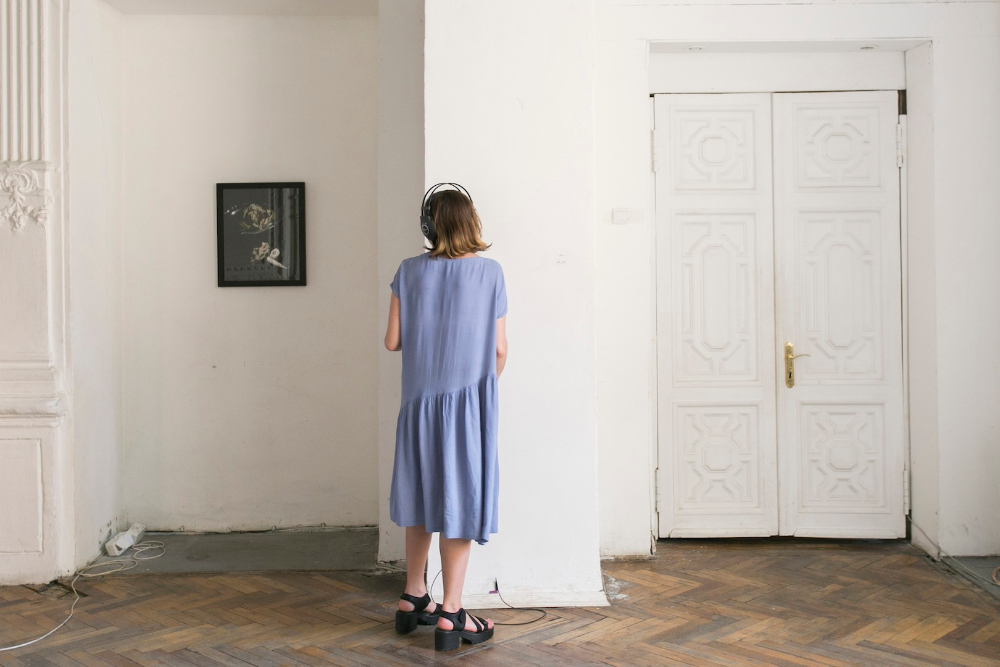
Lina Lapelytė, Yes Really!, 2014; Jurgis Paškevičius, Pass The Cabbage Chips, 2013
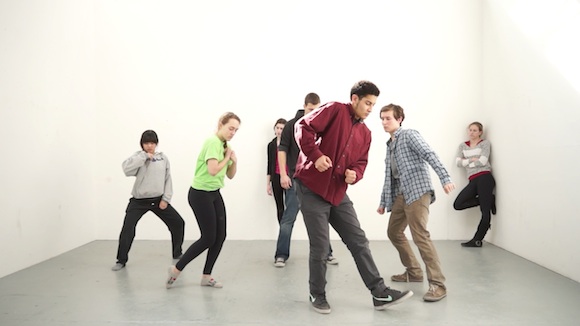
Lina Lapelytė, Candy Shop – the Dance Class, 2013, HD, video still. Courtesy of the artist
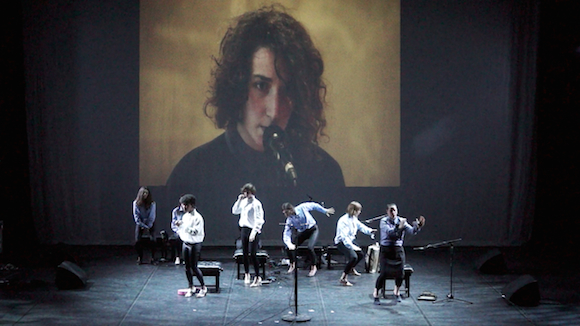
Lina Lapelytė, Candy Shop – the Opera, 2014, performance. Queen Elizabeth Hall, London. Photograph by Federcio Strate Pezdirk. Courtesy of the artist
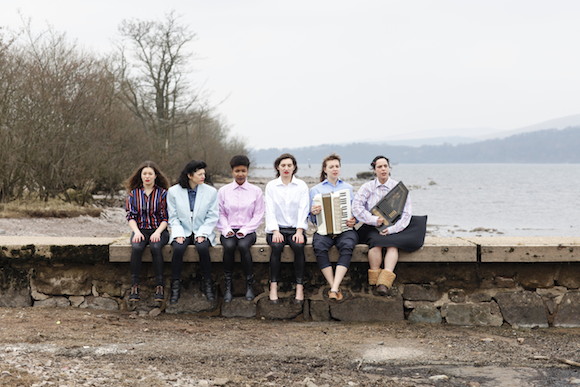
Lina Lapelytė, Candy Shop, performance, 2013, Glasgow. Photograpgh by Federcio Strate Pezdirc
























